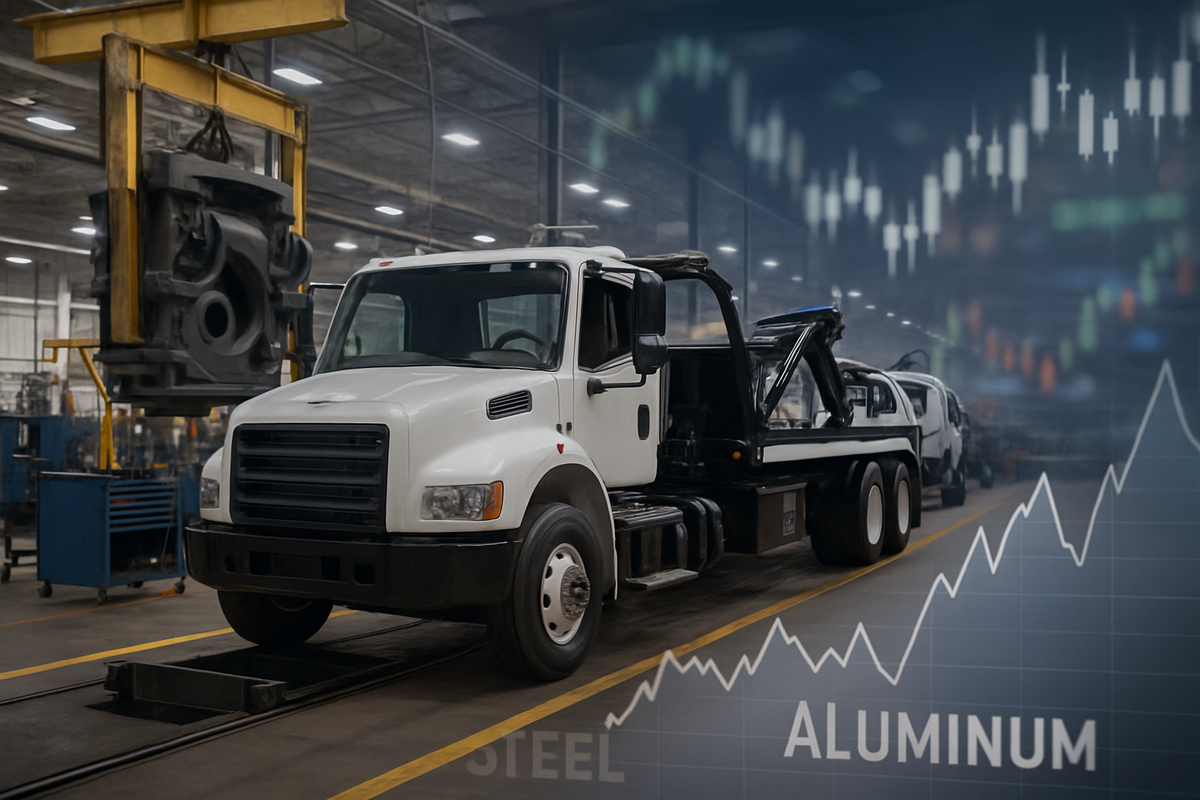Financial News
Miller Industries Inc. Navigates Commodity Crosscurrents: A Value Stock's Battle Against Metal Price Volatility

Ooltewah, TN – October 17, 2025 – Miller Industries Inc. (NYSE: MLR), the world's leading manufacturer of towing and recovery equipment, finds itself at a critical juncture, wrestling with the dual pressures of fluctuating metal commodity prices and broader market shifts. As investors increasingly scrutinize the long-term viability of value stocks in a volatile economic landscape, the performance of Miller Industries' shares hinges significantly on its ability to manage the rising costs of essential raw materials like steel and aluminum. This dynamic interplay will largely determine whether the specialized vehicle manufacturer can outperform a general basket of value stocks in the coming months and years.
The immediate implications are already evident, with Miller Industries reporting recent declines in net sales and a workforce reduction, signaling the tangible impact of these market forces. While the company maintains a strong market position and a history of financial prudence, the persistent volatility in metal prices, coupled with supply chain disruptions and softening demand, casts a shadow over its near-term outlook. The question for investors is whether Miller Industries' inherent value, robust distribution network, and strategic adaptations can effectively counterbalance these commodity-driven headwinds.
The Unyielding Grip of Metal Prices on Manufacturing
Miller Industries Inc. designs and produces a comprehensive line of wreckers, car carriers, and transport trailers, which are then integrated with third-party truck chassis. The foundational elements of these products—the bodies of wreckers and car carriers, along with various trailer parts—are heavily reliant on metals, particularly steel and aluminum. Consequently, fluctuations in the prices of these commodities directly and significantly impact the company's cost of goods sold (COGS), profit margins, and necessitate adaptive pricing strategies.
Historically, periods of rising metal prices, such as those spurred by the 2018 Section 232 tariffs on steel and aluminum, have translated into increased input costs for Miller Industries and other downstream manufacturers. More recently, post-COVID-19 supply chain disruptions and inflationary pressures further exacerbated this trend. While the fourth quarter of 2023 saw some stabilization in raw material costs contributing to an improved gross margin, the second quarter of 2025 painted a different picture, with the company facing "elevated costs of ownership" and reduced retail sales, leading to strategic workforce reductions. As of October 17, 2025, aluminum futures have surged past $2,780 per tonne, reaching over a three-year high, driven by tight supply and bullish demand expectations, further compounded by a major fire at Novelis' Oswego facility. Steel prices, while showing some recent declines in China due to weak construction demand, have seen significant increases in the U.S., largely due to the reinstatement and expansion of tariffs, with some predicting a market bottom and potential uptick by December.
Miller Industries: A Value Play Amidst Commodity Headwinds?
Miller Industries (NYSE: MLR) exhibits many characteristics typically associated with a value stock: it often trades below its perceived intrinsic worth, has a history of paying dividends, and boasts a relatively low debt-to-equity ratio. However, its direct exposure to metal commodity prices distinguishes it from a broad, diversified basket of value stocks that might include companies in less raw-material-intensive sectors like finance or utilities. For Miller Industries, rising steel and aluminum prices directly inflate production costs, compressing profit margins if these increases cannot be fully passed on to customers. Conversely, a decline in metal prices could provide a significant boost to profitability by reducing input costs.
Compared to a broad value index, Miller Industries' financial performance is more acutely tied to the commodity cycle. While inflation can sometimes benefit value stocks by boosting asset values, a manufacturing firm heavily reliant on specific raw materials might see these benefits negated by its increased operational costs. Other publicly traded companies in the heavy equipment and specialized vehicle manufacturing sector face similar vulnerabilities. Giants like Caterpillar Inc. (NYSE: CAT), Deere & Company (NYSE: DE), and CNH Industrial N.V. (NYSE: CNHI), all heavily dependent on steel and other metals for their products, would experience comparable impacts from metal price fluctuations. Their ability to manage these costs through strategic sourcing, hedging, and pricing power is paramount to their sustained profitability and competitive standing.
Broader Currents: Industry Trends and Regulatory Tides
The current metal commodity price trends are not isolated events but rather fit into a broader tapestry of industry shifts and regulatory actions impacting the heavy equipment and specialized vehicle manufacturing sectors. The global push towards electrification, particularly in electric vehicles (EVs) and renewable energy infrastructure, is a significant structural driver for metals like copper and aluminum, ensuring sustained demand growth in these "energy transition sectors." This demand, coupled with persistent supply constraints and geopolitical tensions, creates a "perfect storm of volatility and disruption."
These trends create ripple effects throughout the supply chain. Competitors that can effectively manage increased raw material costs through optimized supply chains, alternative materials, or robust hedging strategies may gain a competitive advantage. Conversely, those less prepared could face margin erosion and market share losses. Supply chain partners are compelled to renegotiate contracts, diversify sourcing, and grapple with higher logistics costs. On the regulatory front, U.S. tariffs on imported steel and aluminum directly increase material costs for domestic manufacturers like Miller Industries. Additionally, regulations like the Inflation Reduction Act (IRA), with its sourcing restrictions for EV battery components, and the Uyghur Forced Labor Prevention Act (UFLPA), demanding supply chain transparency, add layers of complexity and cost to raw material sourcing. Historically, periods of warfare, economic recession, and rapid global growth have all been marked by similar commodity price volatility, underscoring the cyclical nature of these challenges for industrial manufacturers.
Navigating the Road Ahead: Strategies and Scenarios
For Miller Industries, the short-term outlook (2025) remains challenging, with revised revenue guidance reflecting continued chassis supply issues and softer order volumes. However, management anticipates a recovery in the second half of 2025, buoyed by healthy long-term demand for towing and recovery services, driven by an aging vehicle fleet. Long-term prospects are also supported by the company's focus on product diversification, new product launches, and military contracts.
To navigate this environment, Miller Industries may need to consider strategic pivots. Implementing financial hedging strategies using futures and options could help stabilize raw material costs. Diversifying its supply chain to reduce reliance on single suppliers or regions is crucial for resilience against geopolitical disruptions and trade tensions. Flexible pricing models that allow for the passing on of increased material costs, where market conditions permit, are essential for preserving margins. Strategic inventory management, moving beyond strict "just-in-time" models, could also provide a buffer against supply shortages. Finally, continued investment in operational efficiencies and product innovation, potentially exploring alternative materials or more efficient designs, will be key to offsetting rising commodity costs.
In a bearish scenario, persistent commodity volatility, coupled with sustained demand softness, could lead to continued underperformance relative to other value stocks. A base case sees Miller Industries gradually recovering as it implements strategic adaptations and broader economic conditions stabilize. A bullish scenario, however, would involve aggressive and effective risk management, leading to significant revenue growth and improved profitability, potentially making MLR a strong outperformer among value stocks.
The Investment Compass: Key Takeaways for the Future
Miller Industries Inc. (NYSE: MLR) presents a compelling, albeit complex, case for value investors. While currently exhibiting traits of an undervalued stock with projected earnings growth and a consistent dividend, its direct exposure to the volatile metal commodity markets remains a significant factor influencing its performance relative to other value plays. The company's ability to navigate these crosscurrents will define its trajectory.
Moving forward, the market will closely assess Miller Industries' capacity to manage its chassis supply chain, which directly impacts production and revenue. Crucially, investors must monitor global metal commodity prices—steel and aluminum in particular—alongside energy costs, geopolitical events, and trade policies that influence these prices. The trajectory of interest rates, global economic growth, and evolving regulatory landscapes, such as the Advanced Clean Truck (ACT) rule, will also play pivotal roles. Miller Industries' internal execution, including its ability to implement cost control measures, optimize inventory, and adapt its product lines to market shifts and new technologies, will ultimately determine its long-term success and its potential to deliver superior returns for investors in the coming months and years.
This content is intended for informational purposes only and is not financial advice
More News
View More




Recent Quotes
View More
Quotes delayed at least 20 minutes.
By accessing this page, you agree to the Privacy Policy and Terms Of Service.



